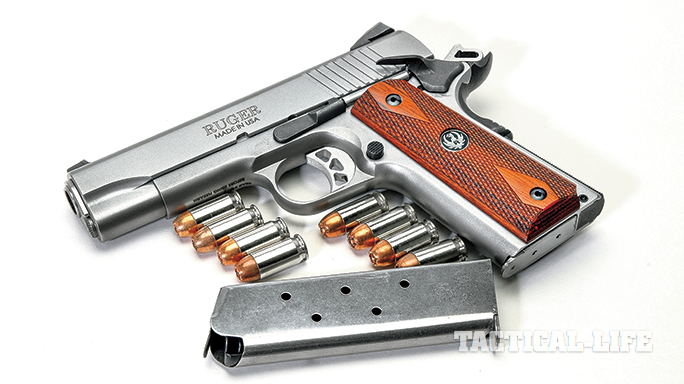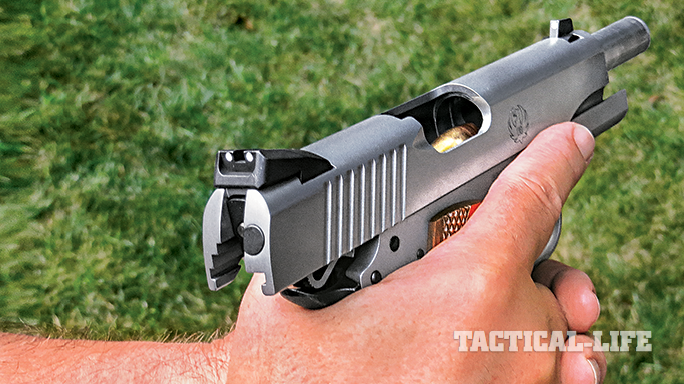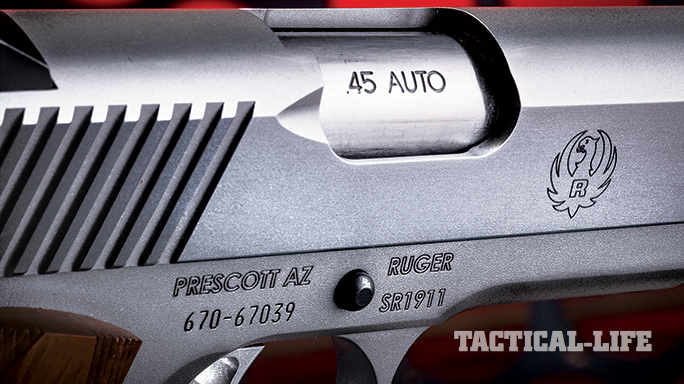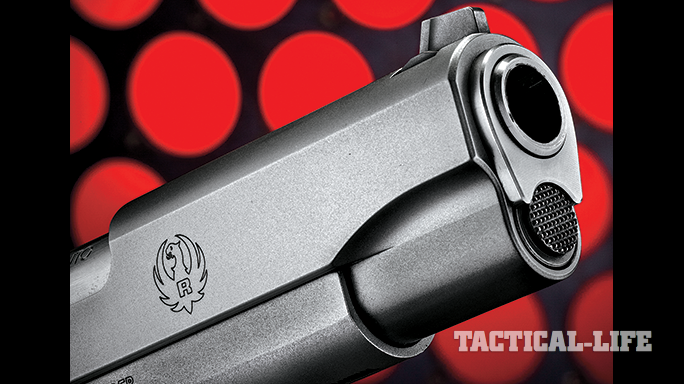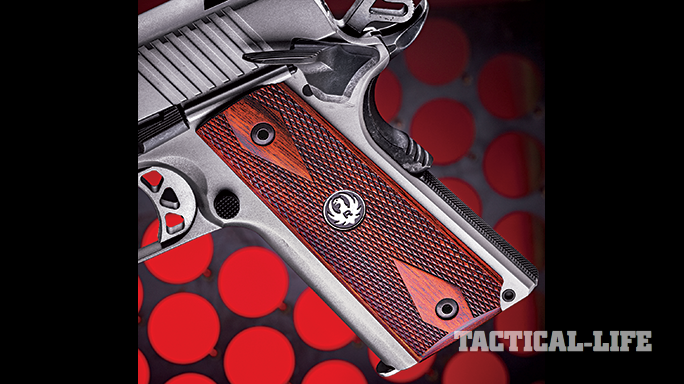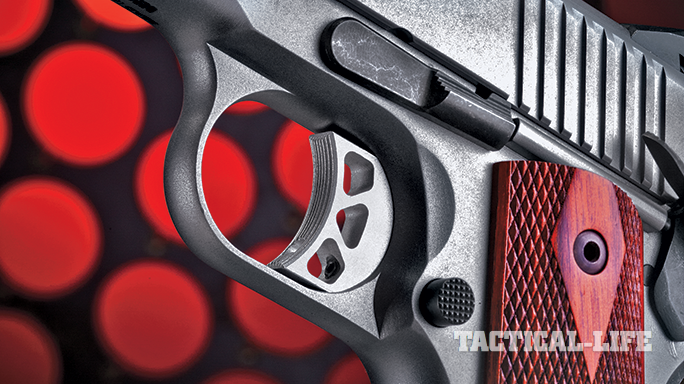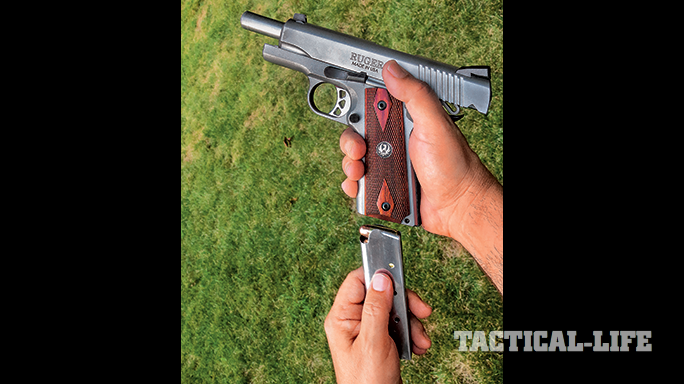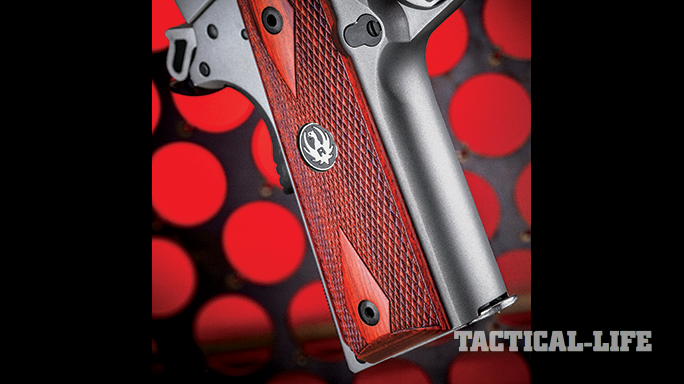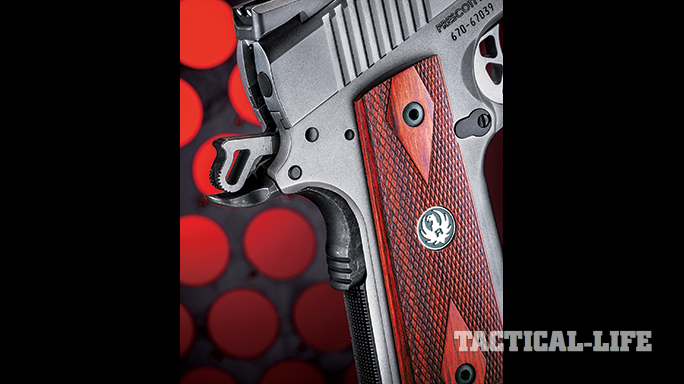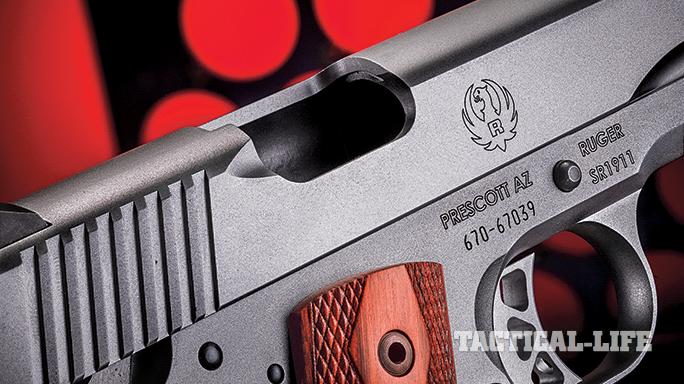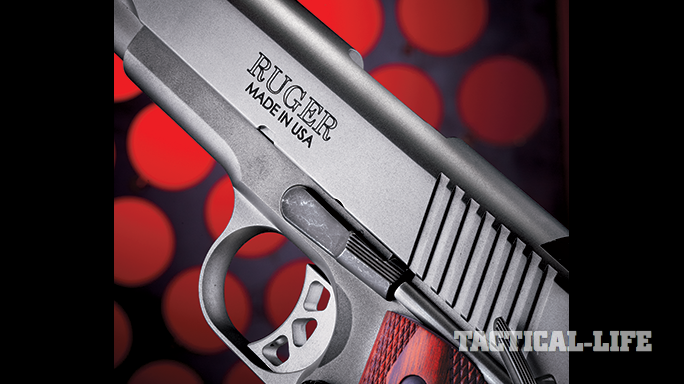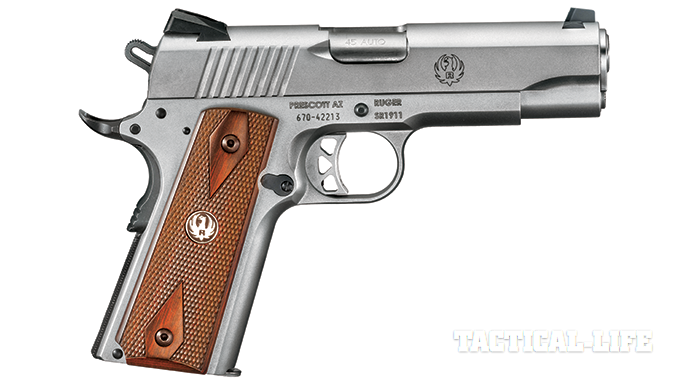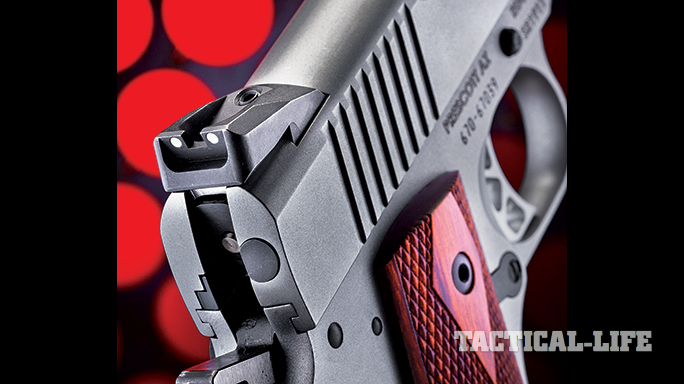In recent years Ruger’s gotten quite cagey about discussing new projects before they’re officially ready to roll on them, partially because of potential legal liabilities and partially because they don’t want their market fans to get overly frustrated if new models take a while to show up on dealers’ shelves after the initial announcements get out. For several years, while it seemed everybody else in the world was building 1911s, whenever Ruger was asked, “When are you going to do one?” the regular response was the official Ruger-code catchphrase, “Ruger has no plans.” In other words, “We don’t want to talk about it yet.”
I used to get it myself, including a period of three or four years back when I was hearing from industry sources that Ruger was quietly looking for vendors to supply small parts for a 1911 pistol design. But when the company’s ready, they’re ready, and until they were, it was just a matter of waiting it out until the new Ruger SR1911 was formally introduced in April of 2011. Since then, the SR1911 has been one of the company’s hottest sellers, with a foregone conclusion that a shorter Commander-sized version wouldn’t be far off. It wasn’t, arriving in 2013, and with a list of features normally running higher than its MSRP of $859.
The SR1911CMD is described by Ruger as being a “Commander-style pistol,” trading on Colt’s 4.25-inch-barreled derivation of their Government Model, since “Commander” has become almost a generic title for the shorter setup. Since “SR1911CMD” has very little pizzazz as a descriptor, and Commander is a Colt model, we’ll just call it the CMD here.
Advertisement — Continue Reading Below
COMMANDER SIZING
The idea behind Commander-sized dimensions was originally to render the full-sized pistol down to a more compact and lighter configuration for military aircrews, and although it wasn’t a procurement success resulting in large government contract sales, it was almost immediately recognized as a very efficient pistol for those who liked the 1911 platform’s power, but not its bulk, for concealed-carry applications. My first exposure to one was at the age of 17, when a very dapper-looking guy in a suit standing next to me at a gun shop counter produced one from under his jacket to discuss it with the clerk. I thought then that it was an impressive piece of hardware that obviously concealed well, since I hadn’t noticed any indications that the plainclothes detective was armed. Years later, my first 1911 pattern was a Commander, and my most customized personal carry pistol still is a Commander. You might say I like the idea, and you’d be right if you did.
Aside from being more concealable, those who favor the shorter barrel often find it can be more dynamic in the hand (as in easier to maneuver) and don’t mind the slight loss of velocity from a 0.75-inch-shorter tube as the tradeoff. There’s also slightly less muzzle for a gun grabber to get a grip on. The pistol uses the same wide range of magazines and popular aftermarket parts as its bigger brother, and it retains that famous “Oh, crap!” intimidation factor that can often shut down anybody making the mistake of looking into its nearly half-inch bore from the wrong end.
Advertisement — Continue Reading Below
There is one often-quoted drawback to the abbreviated top end, though. Conventional wisdom states that the shorter you go with the 1911, the less reliable it becomes. Most professional instructors will advise that if you’re determined to go with a 1911 pattern in today’s modern polymer pistol world, go long for that reason. I’ve never run into reliability issues with my own Commanders, but the specter of cycling failures is always there in trying a new shorter-barreled 1911, as it was when I unlimbered the new CMD at the old quarry for its range session. But, we’ll get back to that. Let’s look at the pistol first.
CMD SPECS
The CMD is a nice-looking representation, and I was honestly surprised to see what was included in the white cardboard box at the price point listed. I’ve been known to drop twice the CMD’s street price of something in the near neighborhood of $650 on aftermarket work alone on a 1911 carry pistol to get several of the same features that already come standard on the stainless Ruger. Those include a matte grey bead-blasted finish; three-dot, windage-adjustable Novak sights; a skeletonized hammer; a lightweight, skeletonized aluminum trigger with an overtravel setscrew; an extended, single-side thumb safety; a beavertail grip safety with a speed bump; a beveled magazine well; a lowered and flared ejection port; a checkered steel mainspring housing; and a throated feed ramp/chamber.
Advertisement — Continue Reading Below
- RELATED STORY: Ruger Makes Mini-14 Tactical Rifle Available in 300 Blackout
A closer look shows excellent machining—none of the razor-sharp edges that I paid extra to have removed on some other 1911s. The CMD has a uniform finish, with lines that are straight where they’re supposed to be straight and curved where they’re not. The slide’s rear doesn’t overhang the frame’s rear, there’s no excessive vertical trigger movement, the thumb safety snicks on and off positively (but not too positively), and there is no hole in the frame around the rear of the thumb safety, as found on some other 1911s, that can collect dust. The frame-to-slide-fit is relatively tight without being too tight; my sample’s barrel was correctly fitted, with no downward play under thumb pressure through the ejection port; the hammer shows a distinct absence of rub marks on either side from contact with the slide during cycling; the dust cover walls are uniform and not thinner on one side than the other; and the rear of the extractor is almost perfectly flush and not clocked at the rear of the slide. These are all key external inspection points for me with new 1911s as indicators of how much attention a given maker pays to details in overall quality, and the new Ruger gets a high rating in those areas.
So, with extra features and an above-average fit and finish, how does Ruger keep the price so low? Alternative materials. If anybody in the gun-making business has a right to look outside the traditional 1911 box, it’s Ruger, a company founded on alternative production methods. John Browning designed the 1911 pistol in an era of very labor-intensive production techniques involving equipment that’s long outdated today, time-consuming processes and materials that were frankly inferior to what’s available now in certain areas such as heat-treating. In bringing out the company’s SR1911 and SR1911CMD, Ruger simply brought it up to modern times with modern processes and modern materials that eliminated a sizable chunk of the costs involved in doing it the old way.
The two biggest cost savers were materials—infinitely quicker-to-produce metal-injection-molded (MIM) small parts and a cast frame—and automated machinery. The CMD’s frame is cast at Ruger Precision Metals. Contrary to popular opinion, there’s nothing inherently wrong with a properly cast 1911 frame, and Ruger’s are the best on the market. Casting allows more consistency in certain dimensions, much less machine time, and when correctly done, there’s no loss of strength or longevity. The Ruger CMD uses a slide machined from 416 stainless bar stock, and the exact composition of the stainless frame is a proprietary secret, but the difference between the two materials eliminates the
galling common to early stainless 1911s by other makers.
Advertisement — Continue Reading Below
A further benefit to this cast 1911 frame is the integral plunger tube that tensions the thumb safety and slide lock on the left side, just above the grip panel. Normally staked on a forged frame, this tube (with its enclosed, double-headed, spring-loaded plunger) is a relative weak point in the 1911’s design in that it can come unstaked, and if it drops off completely, it affects the safety’s ability to lock on or off and hinders the slide lock from doing just that. Here, since the tube is cast as part of the frame, it would take a substantial whack to knock it loose or affect the function of those two important parts.
MIM parts? I know, whether you hate them or don’t care, they’re here to stay, and again, it’s a matter of how well they’re made. Metal-injection molding produces more uniform parts, requiring less human hands-on involvement, and with the right formulation (which advances regularly) in the right spot, it can reduce costs without diminishing function. MIM parts in the CMD include the front and rear sights, hammer, thumb safety, grip safety, sear, disconnector, barrel link, magazine catch, firing-pin stop, slide stop and the ejector—all outsourced to Ruger’s strict specifications, as the company has no MIM production capability of its own.
Elsewhere, the CMD’s barrel is CNC-machined from bar stock in-house with broached rifling. The firing pin is titanium to allow the pistol to pass various drop test requirements without resorting to an internal passive firing-pin block, which the CMD does not have. The included stainless magazines are made for Ruger by Checkmate, a well-known American supplier to several 1911 brands. Finally, the traditional diamond-pattern checkered grip panels are made by Altamont.
Advertisement — Continue Reading Below
DOWNRANGE
First lubed with white lithium grease on its rails, on a 49-degree day in the quarry, the CMD ran through four different factory loads, two 185-grain JHPs and two 230-grain JHPs, at 25 yards without a single malfunction either off the sandbag for accuracy or off my own two feet for rapid-fire controllability, including Black Hills’ steel-cased ammunition. It wasn’t quite perfect, though. The pistol shot consistently 4 inches low at 25 yards, ejection was literally all over the place (bouncing off my forehead, rolling down my shirt front, pinging off my headset ear cup, dropping on the shooting table, arcing back 15 feet over my head, landing on the ground a foot to the right of the table, etc.), and the hex-head grip screws loosened. The extractor is CNC-machined from alloy round stock (not MIM) and can be tuned for more consistent ejection if needed, the grip screws just need a good beginning torque-down, and Ruger was made aware of the pistol’s low point of impact.
Otherwise, the pistol was controllable, reliable with a clean 4.25-pound trigger break, and within the accuracy parameters acceptable for a stock 1911 variant in a defensive role. Like any 1911-style pistol, you can shoot it as is, straight from the maker, or sink more money into “accurizing” with a tighter barrel bushing, night sights and so on.
Advertisement — Continue Reading Below
A full-featured pistol at an entry-level price deserves a hard look for anybody in the market for a new 1911, and a quality Commander-sized version is never a bad carry choice if you can handle .45 ACP power levels.
For more information, visit ruger.com.
- RELATED STORY: Gun Review: The Battle-Ready Ruger AR-556
